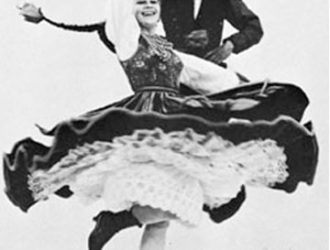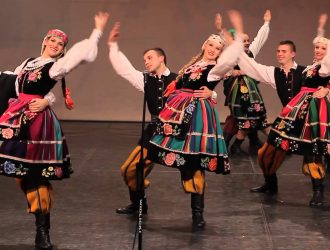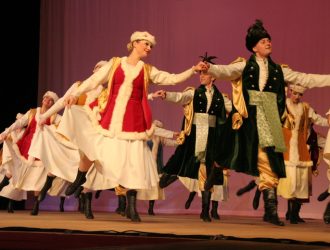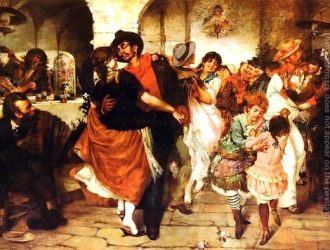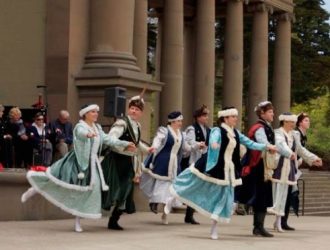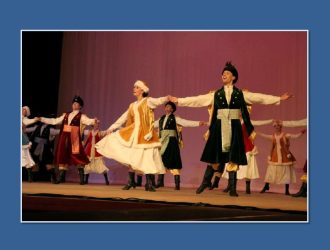Mazurka
The Mazurka (Mazur or Mazurek in Polish) is a lively Polish folk dance, in triple time, intended for a circle of couples and characterized by the stamping of feet and clicking of heels, traditionally danced to the music of a village band.
- Genre:
- Time signature:
3/4 or 3/8
- Accent:
Forceful accent on the second beat
- Tempo:
Lively
- Origin:
The plains of Mazovia around Warsaw, Poland
- Year:
Roughly the 16th century
The music of the Mazurka is in 3/4 or 3/8 time with a forceful accent on the second beat. The dance is highly improvisatory yet more than 50 different steps exist. The music written for the dance is also called Mazurka.
In Polish, this musical form is called “Mazurek” — a word derived from “Mazur,” which up to the nineteenth century, denoted an inhabitant of Poland’s Mazovia region, and which also became the root for “Masuria”. In Polish, “Mazurka” is actually the genitive and accusative case of “Mazurek.”
As a ballroom dance intended for four or eight couples or for single couples, the Mazurka retains room for improvisation. The volume of Mazurkas composed for piano by Frédéric Chopin reflects his interest in the music of his homeland as well as the dance’s popularity in his day. The Varsovienne (Italian Varsoviana) is a 19th-century French couple dance that evolved from a simple Mazurka step.
Even though the Mazurka began as a dance for couples, Mikhail Fokin, a Russian choreographer and dancer, created a female solo Mazurka dance dominated by flying grandes jetés, alternating second and third arabesque positions, and split-leg climactic postures.
History#
The Mazurka originated in the plains of Mazovia around Warsaw, Poland. The people of the province were called Mazurs; thus, the dance Mazur bears the same name as the inhabitants of the region. The dance, known abroad as the Mazurka, comprises the folk origins of two other Polish musical forms: the slow Kujawiak, and the fast Oberek. These dances are linked by common rhythmic and choreographic traits, especially the Mazurka rhythm. The name is much younger than the dance itself and probably originated outside of the region. This term appears for the first time in J. Riepel’s music dictionary published in Germany in 1752.
The dance was known as early as the 16th century. Early lute and organ tablatures feature many instances of the Mazurka rhythm in pieces entitled Polish dance, or in Latin, Chorea Polonica. During the 17th century, the dance spread over Poland and began to appear also in neighboring countries. Distinct versions of these dances could be found in the repertoire of the countryside (the folk Mazur-type dances and the Mazur of the nobility), and the towns (urban Mazurka).
The dance was quickly adopted at the Polish court around the 18th and 19th centuries yet remained a folk dance. Nobles would meet and dance in different countries so the dance became famous internationally. The Mazurka eventually spread to Russian and German ballrooms and by the 1830s, had reached England and France.
Augustus II, the Elector of Saxony and King of Poland (1697-1733) was very fond of this dance and introduced it into the courts of Germany. Following Poland’s loss of independence, the dance became fashionable in higher social circles in Paris, then London, and other centers of Western Europe. In 1830, the British paper, The Observer (25 April 1830) described the Mazurka as “just introduced, or intended to be introduced, into this country.”
In the 1830s and 1840s, the Mazurka enjoyed its greatest popularity in the Western saloons. Along with the Krakowiak and the Polonaise, it served as a sign of solidarity with the oppressed Polish nation, the cause championed by Polish exiles in Paris and their aristocratic patrons. Paradoxically, after the partitions of Poland, the Mazurka also became popular among the Russian aristocracy and peasantry.
An important fact in the history of the Mazurka is its appearance in the Polish national anthem. Mazurek Dąbrowskiego (Dąbrowski Mazurka) was created in 1797 as a Song of the Polish Legion for the troops of General Jan Dąbrowski, serving Napoleon during his conquest of Europe with the hope of regaining Poland’s independence. The melody of the anthem is of anonymous, folk origin. The text was penned by Józef Wybicki. Thus, the fast-paced, energetic dance became a national symbol in several distinct ways.
Characteristics#
The most characteristic feature of the dance is the presence of the so-called Mazurka rhythms, which occur in a variety of non-dancing songs and dances from the central and western parts of Poland. According to current research, it is not possible to describe traits that would unequivocally distinguish an Oberek from a Mazur or a Kujawiak.
The folk dance is improvisatory in character. It is danced by couples who rotate around the dance hall and present a variety of gestures. As an “exhibition” dance, it is regarded as the “most exciting and intricate of the five national dances of Poland” (Ada Dziewanowska: Polish Folk Dances and Songs, p. 509). Dziewanowska described the Mazur as filled with contrasts: “it combines the fiery spirit with pride and elegance, vivacity with lyricism, dignity with joy, and boldness with gallantry.”
The position of the body resembles that of the Polonaise – head held high, torso erect, the graceful motion of the hands. The difference of the character stems primarily from the faster tempo and the presence of irregularly spaced accents, stomps, and clicks of the boots. There are four versions of the Mazur that could be presented by a folk dance group: the dance of the nobility (in 17th-century costumes), the salon dance of the Napoleonic era (in the appropriate military [men] and salon [women] mixture of clothing), the dance of urban folk or a peasants’ dance from central Poland. Each type of dance would emphasize different class characteristics of portrayed strata of Polish society.
There are a number of basic steps: bieg mazurowy (running step), sideways step, sliding step, and the hołubiec (clicking heels together, similar to the step in the Krakowiak). There are also many hand positions, figures, and turns that could be used by couples performing this dance. A different set of group figures is available for ensembles. Thus, the dance leaves much room for the creativity of its choreographer and the spontaneity of individual dancers.
In the Mazurka, the partner shows that he is leading, but the lady is his most important “treasure” so that even the positions of his hands show that he is protecting her. There is such a position where he holds her hand and protects her head from behind.
Costumes#
Since there are at least four different socio-historical versions of the Mazur (17th-century nobility, 19th-century patriotic society, peasants from central Poland, regional varieties from western and south-central Poland, etc.), there are a variety of costumes available for performance.
If the version of the nobility is chosen (at times to music from the classical tradition, e.g. the Mazur from Stanisław Moniuszko’s The Haunted Manor), the clothing should be that of the 17th-century Polish nobility wearing fur-lined jackets (kontusz) and hats. The Polskie Iskry wear a stylization of this costume with women wearing shorter skirts and different shoes that would have been used by the Polish gentry.
The “high-society” Mazur may also be performed by the 19th-century Polish legions (in Napoleonic uniforms, and special square hats bearing the national emblem, an eagle on the front) and their charming partners in Empire gowns, long gloves, and at times light, flowing scarves covering their almost-bare shoulders.
The folk versions of the Mazur, especially from central Poland, could feature the costumes of different regional varieties, for instance, the boldly colored, striped skirts and capes of women from the Łowicz area in central Mazowsze, or any other type of the Mazovian costume (of which there are several).
The regional costumes used by Polish folk dance ensembles differ considerably from historically documented clothes worn by peasants from the region in the 19th century, for instance, the couple from Raszyn, near Warsaw, as represented in Oskar Kolberg’s Pieśni ludu polskiego (1857).
Nonetheless, the dance groups prefer to present the Mazur as the dance of the nobility, reserving the folk costumes for performances of the faster and slower variants, i.e. the Oberek and Kujawiak. It is also possible to find Mazur-type dances in Wielkopolska, Małopolska, or Lubelskie – indeed, with the richness of costumes and the variety of variants available, the Mazur truly is a national dance and may appear in suites of dances from all these regions.
Music#
Several classical composers have written Mazurkas, with the best known being the 69 composed by Frédéric Chopin for solo piano. In 1825, Maria Szymanowska wrote the largest collection of piano Mazurkas published before Chopin. Henryk Wieniawski also wrote two for violin with piano (the popular “Obertas”, Op. 19), and in the 1920s, Karol Szymanowski wrote a set of twenty for piano and finished his composing career with a final pair in 1934.
Chopin first started composing Mazurkas in 1825, but his composing did not become serious until 1830, the year of the November Uprising, a Polish rebellion against the Russian Tsar. It was important to compose Polish music for Polish identity at this time. All his life, Chopin tried to create a Polish national style. Today, the Polish national anthem is a Mazurka. It was when Chopin spent the summer of 1828 at a Palace west of Warsaw that he came in close contact with the dance, seeing and hearing it performed locally.
Chopin continued composing Mazurkas until 1849, the year of his death. The stylistic and musical characteristics of Chopin’s Mazurkas differ from the traditional variety because he, in effect, created a completely separate and new genre of Mazurka all his own. For example, he used classical techniques in his Mazurkas, including counterpoint and fugue. By including more chromaticism and harmony in the Mazurkas, he made them more technically interesting than the traditional dances. Chopin also tried to compose his Mazurkas in such a way that they could not be used for dancing, so as to distance them from the original form.
However, while Chopin changed some aspects of the original Mazurka, he maintained others. His Mazurkas, like the traditional dances, contain a great deal of repetition: repetition of certain measures or groups of measures, of entire sections, and of an initial theme. The rhythm of his Mazurkas also remains very similar to that of earlier Mazurkas. However, Chopin also incorporated the rhythmic elements of the two other Polish forms mentioned above, the Kujawiak and Oberek; his Mazurkas usually feature rhythms from more than one of these three forms (Mazurek, Kujawiak, and Oberek). This use of rhythm suggests that Chopin tried to create a genre that had ties to the original form but was still something new and different.
Around the World#
The Mazurka was common as a popular dance in Europe and the United States in the mid-to-late nineteenth century.
Cape Verde Islands#
In Cape Verde, the Mazurka is also revered as an important cultural phenomenon played with acoustic bands led by a violinist and accompanied by guitarists. It also takes a variation of the Mazurka dance form and is found mostly in the north of the archipelago, mainly in São Nicolau, Santo Antão. In the south, it finds popularity on the island of Brava.
Czech Republic and its Forerunners#
Czech composers Bedřich Smetana, Antonín Dvořák, and Bohuslav Martinů all wrote Mazurkas to at least some extent. For Smetana and Martinů, these are single pieces (respectively, a Mazurka-Capriccio for piano and a Mazurka-Nocturne for a mixed string/wind quartet), whereas Dvořák composed a set of six Mazurkas for piano, and a Mazurka for violin and orchestra.
France#
In France, Impressionistic composers Claude Debussy, Maurice Ravel and Frédéric Chopin all wrote Mazurkas. Debussy’s is a stand-alone piece and Ravel’s is part of a suite of early work, La Parade. Jacques Offenbach included a Mazurka in his ballet Gaîté Parisienne. Léo Delibes composed one which appears several times in the first act of his ballet Coppélia.
The Mazurka appears frequently in French traditional folk music. In the French Antilles, the Mazurka has become an important style of dance and music. A creolized version of the Mazurka is Mazouk, which was introduced to the French Caribbean during the 19th century.
In popular folk dancing in France, in recent years (after roughly 2005), the Mazurka has evolved into a dance at a more gentle pace (without the traditional ‘hop’ step on the 3rd beat), allowing for more intimate dancing and giving it the status of a seduction dance. This style of Mazurka has also been imported into Balfolk dancing in Belgium and the Netherlands, hence the name “Belgian Mazurka” or “Flemish Mazurka“.
Ireland#
Mazurkas constitute a distinctive part of the traditional dance music of County Donegal, Ireland. As a couple’s dance, it is no longer popular. The Polish dance entered the British Isles in the 1840s but is not widely played outside of Donegal. Unlike the Polish Mazurek, which may have an accent on the second or third beat of a bar, the Irish Mazurka (masúrca in the Irish language) is consistently accented on the second beat, giving it a unique feel.
Musician Caoimhín Mac Aoidh has written a book on the subject, From Mazovia to Meenbanad: The Donegal Mazurkas, in which the history of the musical and dance form is related. Mac Aoidh tracked down 32 different Mazurkas as played in Ireland.
Brazil#
In Brazil, the composer Ernesto Nazareth wrote a chopinesque Mazurka called “Mercedes” in 1917. Heitor Villa-Lobos wrote a Mazurka for classical guitar in a similar musical style to Polish Mazurkas.
Cuba#
In Cuba, composer Ernesto Lecuona wrote a piece titled Mazurka en Glisado for the piano, one of the various compositions throughout his life. In Nicaragua, Carlos Mejía Godoy y los de Palacaguina and Los Soñadores de Saraguasca made a compilation of Mazurkas from popular folk music, which are performed with a violin de talalate, an indigenous instrument from Nicaragua.
Curaçao#
In Curaçao, the Mazurka was popular as dance music in the nineteenth century as well as in the first half of the twentieth century. Several Curaçao-born composers such as Jan Gerard Palm, Joseph Sickman Corsen, Jacobo Palm, Rudolph Palm, and Wim Statius Muller have written Mazurkas. In Mexico, composers Ricardo Castro and Manuel M, Ponce wrote Mazurkas for the piano in a Chopin fashion, eventually mixing elements of Mexican folk dances.
Philippines#
In the Philippines, the Mazurka is a popular form of traditional dance. The Mazurka Boholana is one well-known Filipino Mazurka.
Portugal#
In Portugal, the Mazurka became one of the most popular traditional European dances through the first years of the annual Andanças, a traditional dance festival held near Castelo de Vide.
Russia#
In Russia, many composers wrote Mazurkas for solo piano: Alexander Scriabin, Mily Balakirev, Pyotr Ilyich Tchaikovsky. Borodin wrote two in his Petite Suite for piano. Mikhail Glinka also wrote two, although one is a simplified version of Chopin’s Mazurka No. 13. Tchaikovsky also included Mazurkas in his scores for Swan Lake, Eugene Onegin, and Sleeping Beauty.
The Mazurka was a common dance at the balls of the Russian Empire and it is depicted in many Russian novels and films. In addition to its mention in Leo Tolstoy’s Anna Karenina as well as in a protracted episode in War and Peace, the dance is prominently featured in Ivan Turgenev’s novel Fathers and Sons. Arkady reserves the Mazurka for Madame Odintsov with whom he is falling in love.
Sweden#
In Swedish folk music, the quaver or eight-note Polska has a similar rhythm to the Mazurka, and the two dances have a common origin. The international version of the Mazurka was also introduced under that name during the nineteenth century.
USA#
The Mazurka survives in some old-time fiddle tunes, and also in early Cajun music, though it has largely fallen out of Cajun music now. In the Southern United States, it was sometimes known as a Mazuka.
Australia#
Julian Cochran composed a collection of five Mazurkas for solo piano and orchestra.
